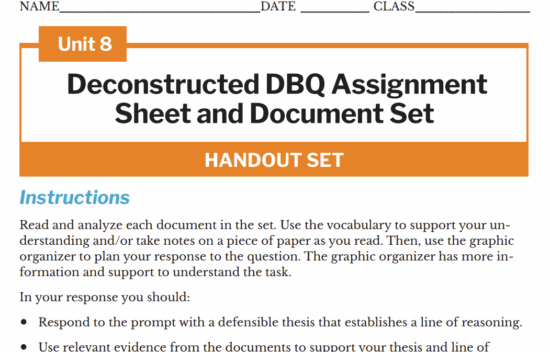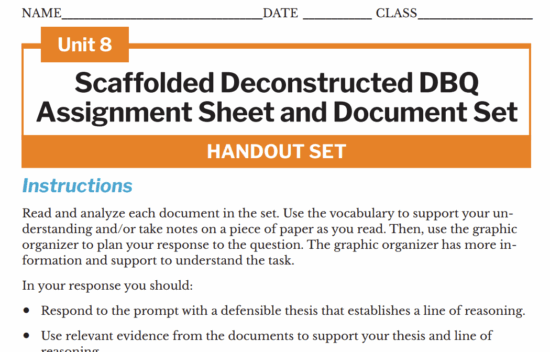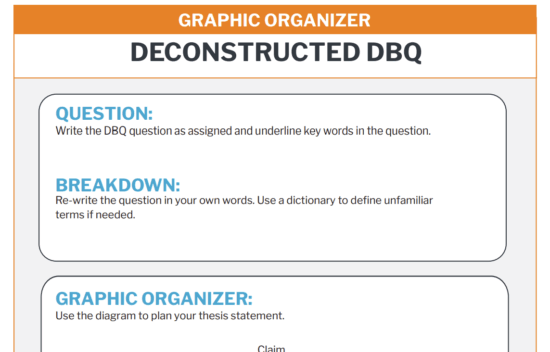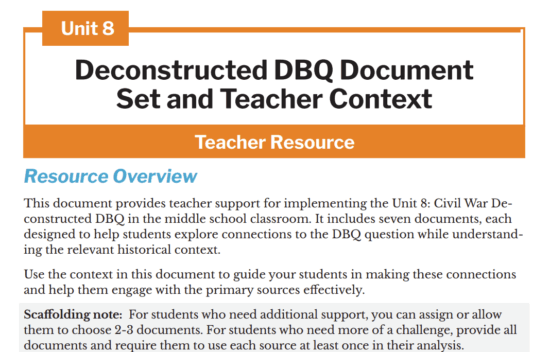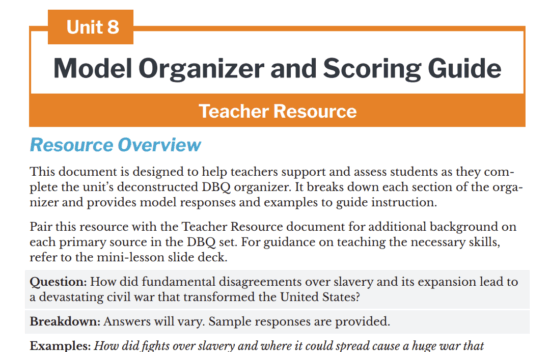
Unit 8: Civil War Deconstructed DBQ
Lesson Components
Guiding Question
- How did fundamental disagreements over slavery and its expansion lead to a devastating civil war that transformed the United States?
Objectives
- Students will provide evidence drawn from primary sources to support a specific thesis.
- Students will provide historical context for primary source documents.
- Students will engage in critical thinking to interpret historical perspectives using VIEW (Voice, Intent, Environment, Who).
- Students will develop a thesis statement using historical evidence.
- Students will group sources based on similarities and historical themes.
Materials
Student Materials
- Document Set (choose 1)
- Deconstructed DBQ Assignment Sheet and Document Set Handout Set
- Scaffolded Deconstructed DBQ Assignment Sheet and Document Set Handout Set
- Documents contained within both sets include:
- Document A: Republican Party Platform
- Document B: Excerpt from Daniel Webster “7th of March” Speech
- Document C: Secession Statement from South Carolina
- Document D: Secession Statement from Georgia
- Document E: Jefferson Davis Inaugural Address
- Document F: Abraham Lincoln’s First Inaugural Address
- Document G: Excerpts from Alexander Stephens’ Cornerstone Address
- Deconstructed DBQ Graphic Organizer
Teacher Materials
- Unit 8 DBQ Slide Deck
- Unit 8 Model Organizer and Scoring Guide Teacher Resource
- Unit 8 Deconstructed DBQ Document Set and Teacher Context Teacher Resource
Teacher Note: There are two versions of the deconstructed DBQ documents. The original version includes light scaffolding and is intended for assessment. The second version is more scaffolded and is intended for using the deconstructed DBQ as a learning activity. The two versions can also be used for different levels of learners in the same class.
Facilitation Notes
- This mini-lesson reinforces all skills that have been introduced in the previous lessons:
- Creating a thesis (Unit 1)
- Grouping primary sources (Unit 2)
- Document summary and analysis- VIEW (Unit 3)
- Adding historical context (Unit 5)
- Using/providing evidence (Unit 7)
- This mini-lesson is intended to take 45-60 minutes and build background knowledge and review skills needed for successful completion of the Deconstructed DBQ. It was created to accompany the mini-lesson teacher slide deck.
- This lesson was created to build upon the previous Deconstructed DBQ lessons. However, it can be implemented in isolation with additional supports. Modify the lesson by using the scaffolding notes to fit your classroom.
Anticipate (Optional)
Deconstructed DBQ skill Video Intro
- Assign, or watch as a whole group, the supplementary Deconstructed DBQ skill video for the unit.
- The video will introduce a new primary source from the time period, give historical context and analysis, and then lead students through using the source to answer the Deconstructed DBQ question with a thesis statement.
- Pause the video at the processing questions embedded in the video to prompt reflection and discussion.
Teacher Note: The Deconstructed DBQ videos work as a pre-teaching tool, but can also be used as scaffolding support later in the mini-lesson. The video is based on a source not included in the Deconstructed DBQ document set, so that the video can be used as a resource in classrooms using the DBQ for skills building, assessment, or both.
Engage
Introduce the Deconstructed DBQ
- Refer to the DBQ question posted on a slide or the board, Tell students: “Today we will investigate how disagreements over slavery and it’s expansion led to the Civil War.”
Document Reading and Annotation
- Distribute the primary source excerpts (Documents A-G).
- Allow students 10-15 minutes to read, annotate independently and then ask any questions they may have.
Scaffolding Note: There are 7 documents in this primary source set. Scale the set to fit the needs of your students if needed. 3-4 documents is a good place to start.
Teacher Note: There are slides in the teacher deck to facilitate a whole-group discussion or reading if your students need more support. There is historical context and more teacher assistance in the DBQ teacher resource document.
Explore
Pass-Pass-Synthesize
- Transition: Arrange students into groups of three seated around a table. Distribute plain lined paper and pencils for each group if needed.
- Each student writes a response to a question for two minutes.
- What were the “fundamental disagreements” about slavery in 1830-1860?
- Papers are passed twice, with each new student adding their thoughts.
- The third student synthesizes the main points from all three responses.
- Step-by-Step instructions with timers are provided in the teacher slide deck for facilitation.
- Display the Possible Support Details from Primary Sources slide from the teacher slide deck, or create a list on the board of possible supporting details that could be used to answer this part of the Deconstructed DBQ question.
- A hidden slide is provided in the slide deck with supporting details and examples, if needed.
Scaffolding Note: Challenge students to accompany their support detail with a piece of evidence from the Deconstructed DBQ documents.
Deconstructed DBQ Graphic Organizer:
- Transition: Distribute the Graphic Organizer, if not already distributed.
- Instruct students to fill in the organizer by:
- Writing the DBQ question and underlining key words
- Breaking down the question by defining unfamiliar terms and re-writing the question in their own words
- Diagraming a strong thesis statement with claim and supporting details/ reasons
- A written thesis statement
- At least 4 selected sources from the DBQ Document set grouped into categories that support the thesis
- Conduct a “VIEW” document analysis for each of the chosen documents
- Provide evidence to connect each document back to the thesis statement and add historical context to the argument
- Slides are included in the Teacher Slide Deck to lead students step-by-step through completing the Deconstructed DBQ Organizer.
Scaffolding Note: Students needing more challenge could be given the opportunity to turn their Deconstructed DBQ into a written response at this stage. This could be a paragraph, or multiple paragraph essay depending on the amount of challenge needed.
Assess
- Students complete their graphic organizer and submit for assessment.
- Collect organizers to assess whether students:
- Provided adequate evidence to support their claims.
- Provided context surrounding several documents.
- Accurately analyzed sources using VIEW.
- Grouped sources based on logical connections.
- Created a clear, defensible thesis.
Teacher Note: A model organizer and rubric are available to assist in assessing student work. You an also use generative AI to help provide individualized feedback for students with prompts like:
- “Evaluate this student response for clarity, evidence use, and historical accuracy. Highlight strengths and areas for improvement.”
- “Does the student’s thesis address the prompt fully and demonstrate understanding of disagreements over slavery and its expansion?”
- “Did the student apply the VIEW method (Voice, Intent, Environment, Who) effectively in their analysis of each document?”
Reflect
Peer Review
- Have students share their organizer with a partner.
- Using the prompts from the slide deck, ask students to review their partner’s organizer.
- Ask students to focus on three aspects of the matrix on the slide.
Scaffolding Note: The peer review could be completed before students submit their graphic organizers for assessment for a formative assessment.
